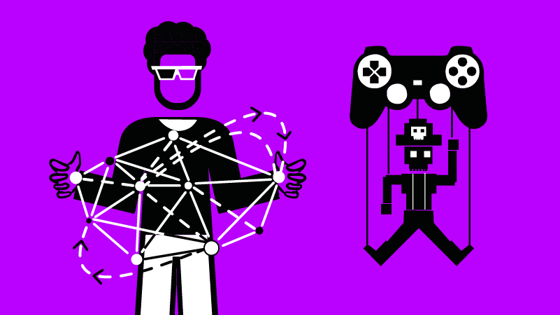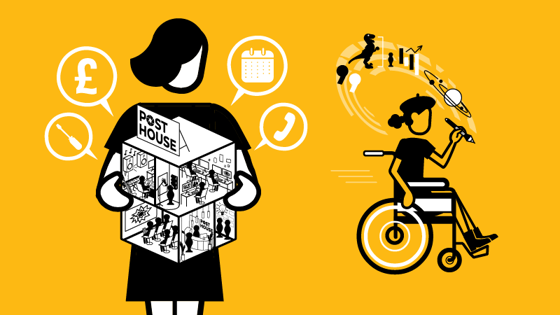Unscripted TV
VT editor
Also known as: EVS operator, VT operator, Picture editor

What does a VT editor do?
VT editors work on studios and outside broadcasts, making the short films that go into a programme. On big entertainment programmes, like Strictly Come Dancing, they make the films that introduce the contestants. On a sports programme, they cut the films that set-up the teams and star players.
“VT” stands for “video tape”. The name derives from the days of pre-digital technology and its stuck. The short film, or insert, is often known as a VT and the person who makes it is the VT editor. VT editors are not the same as the editor on a long form documentary or drama, they are often known as the picture editor and they cut the whole programme from end to end. VT editors in studios and on OBs only edit segments of a programme, though they are sometimes be referred to as a picture editor too.
In recent years an increasingly important editing tool is the “EVS”. EVS is a company that specialises in hardware and software designed for fast turnround inserts on outside broadcast and studio shows. This makes it ideal for cutting highlight sequences in a live programme. So, VT editors are sometimes known as an EVS operators, as they have been specifically trained to use the EVS tools.
The VT editor or EVS operator is often positioned near to the production gallery or close to the OB mobile control room. Working alongside the programme director or producer, the editor selects the best shots and puts them in the right order to tell a great story. It sounds simple - but choosing the images that stand out and cutting them together to create tension and pace takes enormous skill and judgement, especially when time is tight. The film needs to be ready to go on time and at the right duration. It’s not unusual to complete the job just a few seconds before the director puts the film on air.
VT editors and EVS operators for studios and OBs are nearly all freelance, and often specialise in areas such as sport, music, or entertainment. They need to know their subject well, if they are to construct the best narrative. They often work alone, with the producer just coming into to sign the film off as ‘ready for transmission’. A technical background is useful but not essential, the most important thing is to be a great storyteller and make decisions fast.
Read
- BAFTA Guru - Giving Up The Day Job: EVS Operator Charles Fribbens
- Frame 25 - Interview with EVS operator Jason Lynn
What’s a VT editor good at?
- Storytelling: be a savvy editor who can recognise the interesting and important moments in a show or event and assemble them in the best order to create a clear narrative
- Quick thinking: be able to identify rapidly the best shots and decide the best order in which to put them all together
- Subject knowledge: understand the moments in a football match, talent show or political debate that are important and make sure they are in a ‘highlights’ film
- Technical insight: know what equipment is being used in the edit suite – how it all connects into the studio or outside broadcast unit
- Organisation: be systematic and orderly in how you keep track of the inserts, and keep everything in its place for when you need to find a certain clip
Who does a VT editor work with?
VT editors work closely with the programme director and producer.
How do I become a VT editor?
There are many routes to being a VT editor, but it’s good to start with roles that will help you become a fast and efficient editor. You could begin by working as a post-production runner or edit trainee to learn more about editing and storytelling. Alternatively, you could start out as a production runner or floor runner in unscripted TV and get to know how live TV is made. It would be very useful to get work experience with outside broadcast productions that give insight into outside broadcast trucks and machine rooms. In this role it’s important to know both editing and the technical aspects of the equipment used for filming, as well as the software used in the edit suite. Spend your time learning and using editing software.
At school or college:
If you want to go to university, A-levels or Highers in media studies, photography, film studies, art and design, drama and theatre, graphic communication, physics or computing science are useful. Or you might want to take the following Level 3 vocational qualifications:
- NCFE Level 3 Applied General Certificate in Art and Design
- BTEC National Diploma/Extended Diploma in Art and Design
- BTEC National Extended Diploma in Creative Digital Media Production
- UAL Applied General Diploma/Extended Diploma in Art and Design
If you want to go straight into a job or apprenticeship, the following Level 3 vocational qualifications will equip you:
- Aim Awards Diploma in Creative and Digital Media
- OCR Cambridge Technical Diploma in Art and Design (3D DesignOCR Cambridge Technical Diploma in Art and Design (Graphic Design)
- OCR Cambridge Technical Diploma in Art and Design (Photography)
- OCR Technical Diploma in Digital Media (Moving Image and Audio Production)
- BTEC National Diploma in Film and Television Production
- BTEC National Diploma in Film and Television Visual Effects
- BTEC National Diploma in Photography
- UAL Diploma/Extended Diploma in Art and Design
- UAL Diploma/Extended Diploma in Creative Media Production and Technology
Get an apprenticeship:
Apprenticeships are jobs with training. You’re unlikely to find an apprenticeship as a VT editor as such, but you might find apprenticeships in digital media production, which can give you a good grounding in video editing, enabling you to progress from there. Search for apprenticeships in production or editing with broadcasters like BBC and Sky. To find out more, go to what’s an apprenticeship?. Go to where can I find an apprenticeship? to find apprenticeships in your region, or approach companies directly. Find the major broadcaster schemes using the apprenticeships filter in information and resources.
Get a degree:
You don’t need a degree to get into this role, but if you want one then don’t be afraid to study any subject that you really enjoy. If you want to focus on TV production, have a look at ScreenSkills’ list of recommended courses and select one in unscripted TV. We recognise courses with our ScreenSkills Select award where they offer training in the relevant software, dedicated time to building a portfolio and have strong links with the unscripted TV industry.
The NFTS offers a postgraduate course in editing. If you don’t have a degree, you can still apply with a portfolio and be taken into consideration.
Edit:
Make videos. Set up a YouTube channel showing off your work. Go to Build a portfolio to learn how.
Take a short course:
Take a course in editing. Go to the list of training courses recommended by ScreenSkills to see what you can find.
The NFTS also offers short courses in the craft of editing.
Look outside the industry:
Get experience setting up the filming and editing videos for events. Volunteer and find jobs that give you the experience and understanding of editing a story together, as well as hands-on experience of the filming equipment.
Get work experience:
It’s worth trying to get work experience with an equipment rental company or as a freelance video editor for events. This will enable you to get your hands on equipment, learn more about it and get to know people who work in TV.
Network:
Get to know people in the unscripted TV industry by attending events, such as ScreenSkills’ Open Doors. Go to training and opportunities and use the events filter to find out what’s on. Meet professionals and ask them questions about their work, while demonstrating interest in and knowledge of the industry. Offer to provide them with your professional contact details and try to stay in touch with them. Go to network well to learn how to do this.
Network online:
Create a LinkedIn profile. See if there are Facebook pages or other social media groups for people making unscripted TV in your area. There might even be groups for runners and trainees. Join them. Create a ScreenSkills profile. There are a lot of crewing agencies that will charge you to be on their books. Sign up to the free ones initially. Wales Screen, Northern Ireland Screen and other areas offer free crew databases. Find a film office near you and get connected. If you do sign up to paid sites, make sure they specialise in the areas in which you’re interested.
Search for jobs:
Search for jobs as edit assistants, kit room assistants or camera assistants. Regularly check out the broadcasters’ websites. Make use of the ScreenSkills jobs board. You can also send a short speculative letter with your CV to technical managers or vision supervisors.
You might also be interested in...
Being a vision mixer, edit producer or camera supervisor in the unscripted TV industry. You might also be interested in being an editor or digital image technician in the film and TV drama industries.







